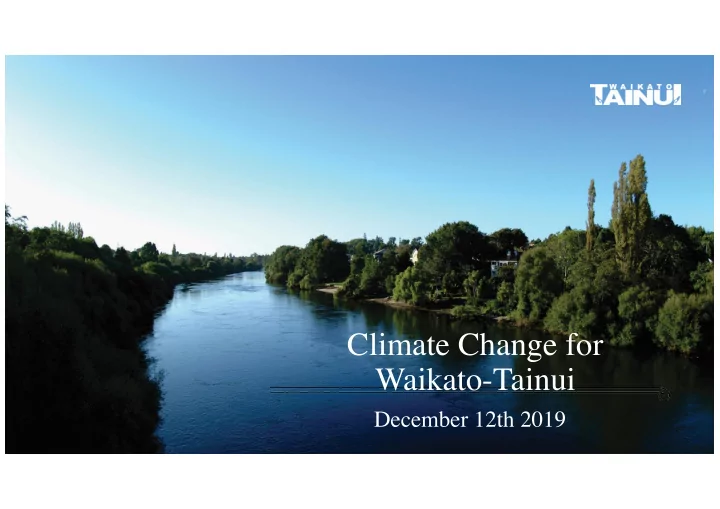

Climate Change for Waikato-Tainui December 12th 2019
Whakatupuranga 2050: Our Vision I am committed to Kiingitanga, fluent in te reo maaori, strong in my tikanga, healthy, well-educated financially secure, environmentally conscious and; socially sound
Key focus for the next five years Taiao • Waikato-Tainui rights and interests in freshwater are clearly defined and understood at a national and regional level • Tribal environmental standards developed to measure the health of our wai and Ka Ka whakamiri noa whakamiri noa i toona i toona aratau, aratau, whenua e tia nei he e tia nei he tupu pua tupu pua hou hou • A trained cohort of tribal members is established who understand our environmental standards and are leading restoration initiatives Working towards the restoration and enhancement of our wai and whenua to the state in Kiingi Taawhiao’s maimai aroha • A scorecard for tribally owned whenua and a progressive approach to restoring our whenua to meet our standards • Understanding the potential impacts of environmental issues like climate change on our Marae and having a plan to respond to and mitigate these impacts Opportunities to collaborate • Co-designing key policy that affect our wai, moana and our whenua • Enhance the capability of our whaanau to contribute to the restoration of our wai and whenua • Restoration Projects • Water Storage • Marae infrastructure and access to clean and safe drinking water
Waikato-Tainui Climate Change Position Whanau Wai Whenua
Waikato-Tainui Engagement Feedback • Representation • Education and Training • Legislative Advocacy • Policy Advocacy • Resourcing
• Waikato-Tainui want to be early adapters in the transition to a low emissions economy. Our Unique status as Mana Whenua and the significant investment we have made as kaitiaki lends itself well to making this transition. • Waikato-Tainui would also promote better integration across the climate change policy framework to deliver mutually beneficial outcomes across all of the wellbeing indicators.
• Waikato-Tainui would also promote greater incentives to increase the uptake of existing environmentally friendly technology. • To combat this growing threat to society, we must control greenhouse gas emissions now. Our teams are working alongside our marae to understand what it is that they are doing e.g. solar panels and the small things we are doing to reduce our carbon footprint.
• Waikato-Tainui are seeking: - A change of discourse around climate change to recognise its crisis state and to focus on the urgency needed for action. - Iwi/Crown led climate change work programme that focuses on ensuring our Iwi understand the impacts of climate change and that they have the appropriate tools and mechanisms to respond to the impacts of a rapidly changing climate (specifically in relation to our people); - Inclusion on any discussions that may be occurring on changes to the current Climate Change legislation.
• Waikato-Tainui are seeking: - Inclusions on the newly established Climate Change Commission. - Greater transparency of the nature and impact of different financial levers. - An integrated approach which delivers a range of new opportunities with a focus on the protection and enhancement of the natural environment. - Technological considerations should form part of the decision-making process however, the health and wellbeing of the environment should come first and foremost.
• Waikato-Tainui are seeking: - Inclusion in the relevant research and development funding decisions on Climate Change; and - A range of amendments to the ETS, including but not limited to the removal of the distinction between pre-1990 and post-1990 forests and the inclusion of wetlands into the ETS and; inclusion of indigenous forests into the ETS.
Leveraging Te Ture Whaimana Mo Te Awa o Waikato
TE TURE WHAIMANA: VISION AND STRATEGY • The vision and strategy is the primary document for the Waikato River. It focuses on restoring and protecting the health and wellbeing of the river for future generations. It will be: • Incorporated directly into the Waikato regional policy statement; • Reviewed by the new Waikato River Authority to add targets and methods as necessary; • Given effect under the Resource Management Act 1991 and conservation and other relevant legislation; • Given the status of a statement of general policy under conservation legislation; and • Recognise and provide for the Vision and Strategy under the Fisheries Act 1996
WAIKATO TAINUI OBJECTIVES • Formed the basis of the Vision and Strategy • Incorporated directly into the Vision and Strategy • Additional objectives reflecting the interests of all New Zealanders also contribute to the basis of the Vision and Strategy
TE TURE WHAIMANA OBJECTIVES & CLIMATE CHANGE OBJECTIVE A The health and wellbeing of the Waikato River is protected from the impacts of Climate Change OBJECTIVE B Failing to protect the Waikato River and its wellbeing from the impacts of Climate Change is failing to protect the Waikato Tainui relationship with the river. OBJECTIVE E Climate Change mitigation and adaptation is only achievable through a integrated, holistic and coordinated approach to the management of the natural, physical, cultural and historic resources of the Waikato River. OBJECTIVE F The adoption of a precautionary approach towards climate change to stop the acceleration of climate change that may result in significant adverse effects on the Waikato River, and in particular those effects that threaten serious or irreversible damage to the Waikato River.
TE TURE WHAIMANA OBJECTIVES & CLIMATE CHANGE OBJECTIVE G The recognition and avoidance of adverse cumulative effects, and potential cumulative effects, of activities undertaken both on the Waikato River and within its catchments on the health and wellbeing of the Waikato River. OBJECTIVE H The recognition that the Waikato River is degraded and should not be required to absorb further degradation as a result of human activities. OBJECTIVE I The protection and enhancement of significant sites, fisheries, flora and fauna. OBJECTIVE M The application to the above of both Maatauranga Maaori and latest available scientific methods.
Further Paatai?
Supporting Documents Te Mana o te Awa Mana Whakahaere Mana Whanake
Recommend
More recommend